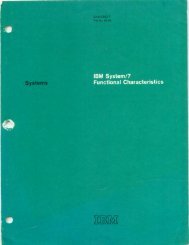IBM 2250 Display Unit Model 4 - All about the IBM 1130 Computing ...
IBM 2250 Display Unit Model 4 - All about the IBM 1130 Computing ...
IBM 2250 Display Unit Model 4 - All about the IBM 1130 Computing ...
You also want an ePaper? Increase the reach of your titles
YUMPU automatically turns print PDFs into web optimized ePapers that Google loves.
to loop from <strong>the</strong> end of <strong>the</strong> display program to <strong>the</strong><br />
beginning, <strong>the</strong>reby maintaining continuous regeneration<br />
without CPU program intervention. ) The<br />
Start Timer order causes a 25ms timer to be<br />
tested. If <strong>the</strong> timer is running, storage accessing<br />
for information following <strong>the</strong> Start Timer order is<br />
delayed. When <strong>the</strong> timer stops, completing <strong>the</strong><br />
current 25ms time period, it is restarted, and<br />
storage accessing automatically is resumed.<br />
The Start Timer order should be included in<br />
each regeneration sequence. The regeneration<br />
rate is variable up to a rate of 40cps (25ms frame<br />
time) and is determined by <strong>the</strong> regeneration timer<br />
or by <strong>the</strong> amount of displayed information.<br />
(Messages that require less than 25ms to regenerate<br />
are displayed at <strong>the</strong> maximum rate of 40cps. )<br />
Note that a flicker-free display image can be<br />
obtained with a regeneration rate of 35 to 40cps.<br />
The Start Timer order also allows keyboard<br />
interrupts and initiates testing of <strong>the</strong> light-pen<br />
switch. An alphameric or programmed function<br />
keyboard interrupt can be generated only during<br />
execution of a Start Timer order.<br />
Programming Notes:<br />
1. Failure to use a Start Timer order in a<br />
short display program may result in damage<br />
to <strong>the</strong> CRT screen or in variable intensity.<br />
2. The Start Timer order should be used as <strong>the</strong><br />
first order in a sequence of graphic orders<br />
that generates a particular display.<br />
Subroutine Linkage Orders<br />
Subroutine linkage in <strong>the</strong> display program is<br />
accomplished by means of a revert register. Each<br />
time a branch order is executed, a return address<br />
is saved in <strong>the</strong> revert register. This address<br />
points to <strong>the</strong> storage location following <strong>the</strong> location<br />
that contains <strong>the</strong> branch order. The return address<br />
is used by two orders: Revert and Store Revert<br />
Register.<br />
Revert (RVT)<br />
0 0 1 1 0 I 1 0<br />
0 3 4 7 8 /5<br />
Main Program<br />
,yzse,,A;<br />
0 0 I I 0 1 0 1<br />
Revert Regi ter Storage<br />
Subroutine<br />
A Ns g<br />
A<br />
Subroutine orders<br />
(non-branch)<br />
N GSB A or data<br />
N+1<br />
r/A<br />
0 3 4 7 8 15<br />
RVT<br />
V<br />
In this example, address N+1 is placed in <strong>the</strong> revert<br />
register as <strong>the</strong> Short Branch order is executed.<br />
This address is <strong>the</strong>n placed in <strong>the</strong> address register<br />
when <strong>the</strong> Revert order is executed, effecting a<br />
return of operations to address N+1. Note that <strong>the</strong><br />
same function is performed when <strong>the</strong> revert bit is<br />
set in a character data stroke word.<br />
Store Revert Register (SRVT)<br />
N<br />
N+1<br />
This order causes <strong>the</strong> revert register contents to be<br />
placed into storage as <strong>the</strong> second word of this order.<br />
It is used when more than one branch is to be<br />
executed before returning to <strong>the</strong> main program (i.e. ,<br />
for multilevel subroutining). For example, a<br />
Store Revert Register order would be executed<br />
before a second branch is issued. After <strong>the</strong> second<br />
branch, a third branch, with indirect addressing<br />
specified, can be used to return by way of <strong>the</strong><br />
stored revert register contents as follows:<br />
Main Program<br />
Revert<br />
1st Subrou ine Reg<br />
SRVT<br />
A GSB B11 Arl<br />
Art<br />
1<br />
Non-branch<br />
orders<br />
and/or data<br />
BIN • GB 1<br />
Var.<br />
2nd Subroutine<br />
Non-branch,<br />
orders<br />
and/or data<br />
GOB C C N RVT<br />
Bit<br />
This order causes <strong>the</strong> revert register contents (<strong>the</strong><br />
return address) to be loaded into <strong>the</strong> address<br />
register. It is used to return from a single-level<br />
subroutine, as follows:<br />
Since <strong>the</strong> revert register contents can be modified<br />
only by a branch order, interrupted subroutines<br />
can be restarted at <strong>the</strong> point of interrupt.<br />
26
















